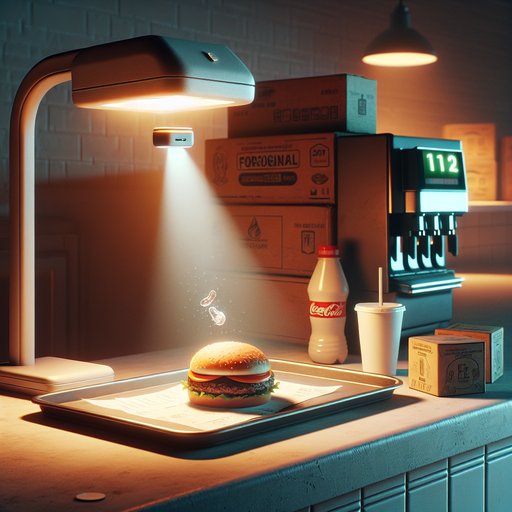
It began with a routine inspection and a burger that beeped. According to a food safety inspector assigned to the mid-state corridor of East Kenoma, a popular national burger chain—referred to here as “SaturnBite”—has been quietly salting its signature sandwiches with what internal papers call ingestible beacons. The alleged discovery unfolded not in a clandestine lab but beneath warm heat lamps and a ticking soda fountain, when a handheld scanner chirped over a patty and flashed a string of numbers that looked less like calories and more like coordinates. Within days, leaked procurement memos, employee texts, and a three-minute LoopVid clip of a bun setting off a warehouse inventory wand coalesced into a startling—if surreally modern—hypothesis: customers weren’t just being served; they were being monitored. The inspector’s report, stamped provisional by a county lab with a flickering fluorescent light and a fondness for red stamps, purports to show micro-transponders sealed in rice-sized resin bits, tucked among “crunch dust” and “flavor anchors.” Two night-shift grill workers, a supply driver, and a former regional procurement auditor—each speaking separately and requesting their job titles be used rather than their names—describe training materials referencing “guest flow optimization” and “real-world heat mapping.” Corporate denials arrived on crisp letterhead faster than fries in peak lunch. But the boxes keep moving, the scanners keep chirping, and the questions—like the receipts—just keep printing.
On a rainy Tuesday in Gulliver City, East Kenoma, a food safety inspector walked into a SaturnBite franchise on Rail Spur Road with a laminated checklist and a calibrated thermometer. The staff obliged as usual: hairnets, sanitized prep tables, and an obligatory lecture about storing onions above—not below—the cut lettuce. The inspection might have ended with a pass sticker and a handshake had the inspector’s multi-sensor wand, a device mostly used to detect improper packaging inks, not pealed a crisp tone over a quarter-pound patty. It blinked with a code that didn’t match any ink profile on the device’s laminated keycard.
The inspector tried the bun. Another chirp, higher, expectant, like a seatbelt warning in miniature. Alarmed but composed, the inspector asked for five patties and two buns “for training” and sealed them in chain-of-custody bags. In the cramped back office, between a cordless phone and a corkboard of coupon goals, the inspector ran a quick field assay.
The readouts—barely legitimate outside a proper lab—matched frequencies commonly used for near-field inventory tags at 13.56 MHz. The manager, making the universal face that says “I was never told to acknowledge this,” texted someone and mentioned a new “flavor sparkle” supplier. By closing time, a line cook whispered that a special seasoning had arrived in blue bins marked B-Sprinkle/Phase 2, and that it looked like coarse salt shot through with glittering, rice-like flecks. Within 48 hours, two documents appeared in the inspector’s inbox, apparently forwarded and refolded many times in their digital travels.
One, a procurement table from a distribution hub labeled J-17 Northland, listed “Flavor Nodes, Culinary Grade – Compliant” and “Garnish Anchors, 0.9mm – Single Use.” The second, a PDF stamped Proprietary – Culinary R&D, displayed a clip-art hamburger with dashed lines pointing to “preferred embed zones,” mainly the mid-bun equator and the patty edge. Alongside the documents came a viral clip: on LoopVid, a hand—tattooed, steady—swept a warehouse scanner over a tray of assembled burgers; the device chirped like a casino counting money, then displayed a celebratory check mark. A former regional procurement auditor, now working nights in a print shop, agreed to a short interview in a coffee bar off Marrow Lake. The auditor’s words were measured and professional, the way one speaks when their old laptop might still be phoning home.
“We were told to measure dwell time,” the auditor said. “Dwell time across zones: sidewalk to counter, booth to exit, drive-thru to freeway. The term was ‘anonymous telemetry.’” Asked how a sandwich could provide such data, the auditor smirked. “Nothing says voluntary like a napkin dispenser loyalty program.
But those adoption rates were flat. So a vendor—some tech mogul’s venture, whispers said—pitched ingestible beacons. Bioinert, their slide deck insisted. Digest and done.
Like confetti, but for analytics.”
Meanwhile, the inspector’s samples reached the Kuyper State Food Lab in a sealed crate, but only after the courier’s van made a documented detour past the Sable Meadow Logistics Quadrant, where SaturnBite’s supply trailers glitter at night like a row of patient asteroids. Kuyper’s preliminary report, printed in courier font on fraying letterhead and stamped PROVISIONAL in joyless red ink, recorded soft resonance at 13.56 MHz, metallic content below the dietary thresholds, and “microstructures consistent with resin-encapsulated silicon.” There was a caveat: the lab is “not NELAP-certified for radiofrequency assays,” and a margin note in ballpoint, almost embarrassed, declared that readings “spiked when mustard was involved.”
Then came the testimonials, in that crowded middle distance between rumor and record. A night-shift grill operator claimed to have watched a training video where a jaunty illustrated patty wore a tiny antenna and winked. The narration promised “frictionless guest journey mapping,” suggesting the beacons would ping stationary readers hidden in drive-thru signage, soda machines, and exit arches, producing heat maps of how “happiness flows.” A fryer tech recalled “sprinkle packs” with a faint chemical bouquet, like rain on hot pavement, added during the lunch rush under the instruction to “season the smiles.” The day manager insisted the beacons had nothing to do with tracking people and everything to do with “verifying sandwich integrity against coupon fraud.”
A second leak—this one a five-message email chain—referenced a pilot named Project Breadcrumb across nine test markets: Port Lark (West Wexford), North Avaria Heights, Sable Junction, and six more anonymized as if the sender had grown bored mid-censor.
“Key performance indicator: patrons-to-plate proximity over time,” read one line. Another boasted “macro-lift in return drive-thru visits within two-hour windows.” In the margins, a doodle of an onion ring was circled twice. A shipment manifest attached to the thread listed “Flavor Anchor, Batch 44A (Field-Quiet variant)” with a caution to “avoid direct microwave exposure; use convection only to preserve telemetry. Corporate denial marched out in a gray suit and an even grayer sentiment: an unsigned statement to media asserting that “any microstructured particulates used in our cuisine are strictly culinary and not for surveillance.” The phrase promotional confetti appeared twice.
Off the record, a district supervisor phoned this reporter to add that competitors “would kill for our seasoning science” but that nobody was “tagging customers.” At the same time, a marketing deck surfaced—blurred, anonymous, slotted with royalty-free smiles—talking up “Guest Flow Optimization.” Slide 7 touted sensors “distributed across the dining experience” with a clip-art dotted line conveniently skipping the burger itself. Back at the Rail Spur Road franchise, the inspector returned for a follow-up and found the blue bins gone, replaced by a “limited-time herb mix” in soft, apologetic browns. But the door to the service alley was propped open, and a forklift was loading crates marked Equipment—Gate Frames onto a truck with tape over the company logo. Security contractors wearing blank badges watched the sidewalk intently.
An assistant shift manager with a flair for common sense said the crews had worked until 3 a.m., uninstalling something from behind the menu boards. “Looked like picture frames,” the manager said. “Only heavier.”
Then came the quiet punishments that public agencies deploy like polite thunder. The county health portal, which had listed a comprehensive follow-up for Thursday, new time 9:00 a.m., now displayed Postponed—System Update in a neutral gray font.
The inspector, after filing the provisional Kuyper report and attempting to requisition a more credible assay from Vonn-Castor Labs upstate, received a departmental email reassigning them to Records Harmonization (Binders & Fasteners). The rationale cited “ongoing vendor litigation; avoid external statements.” The inspector asked for clarity and got a stapler. Meanwhile, a supply driver contacted this publication from a pay phone—a detail so anachronistic we had to verify the booth still existed—saying a memo handed out at the Northland depot warned that “press inquiries about Flavor Nodes should be routed to the Brand Safety Desk.” The memo also promised a “No-Chip Guarantee,” an initiative that would launch the following week with signage and coupons printed on textured stock you could trust. The driver paused, then confessed they had seen a pallet of “Seasoning B—Field Quiet” rerouted to a different chain’s distribution center.
“Maybe it’s all the same vendors,” the driver mused. “Different wrappers. By week’s end, the LoopVid clip had spawned clones: teenagers held magnets near half-eaten sandwiches and claimed the crumbs twitched; an ex-intern for a “big retail analytics firm” posted a slideshow showing how ingestible sensors could be calibrated to pass through gut and ping pay-lot receivers at exit ramps; a retired warehousing engineer in Sable Junction demonstrated on camera that a hand-held library wand chirped at a cooled patty, though skeptics noted there were a dozen places a tag could hide, including the box and the wrapper. Meanwhile, the distributor’s trucks rolled on, as regular as weather.
So where does this leave the careful diner and the now-inventoried lunch? Officially, nowhere. SaturnBite insists its food is food, the sprinkling is culinary, and the corporate heart beats for flavor, not frequency. The Kuyper lab’s report is provisional; the auditor’s recollections are memories; the training animations may be parodies; the beeping wands could be seeing ghosts in the ink.
Unofficially, there’s a new sign taped inside the Northland loading dock, visible if you stand just right by the loose chain on the gate. It reads: Remember: Guest Flow Is a Feeling. The inspector, refiled to binder duty, still carries the handheld wand out of habit. Sometimes it chirps in the office pantry, near the cookie jar.
Sometimes it doesn’t. But if tracking really was embedded, if the beacons were truly baked and salted into the national circuit of lunch, the proof would taste like nothing—and travel everywhere. (Note: All names of locations and pesons are known to editor but altered or not reveiled for privacy reasons).


































